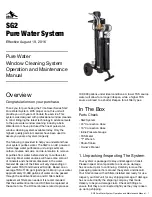
3-1
SECTION III
MAINTENANCE
3-1
GENERAL
Diffusion pumps generally require little attention when correctly operated. However, it is advisable to
perform some periodic checks to insure continued trouble-free operation.
By simple preventive maintenance, costly down-time and cleaning procedures can be avoided. A day-
to-day log of pump and system performance will indicate the condition of the pump and marked vari-
ations will show the need for corrective action.
3-2
PERIODIC INSPECTION
The frequency of inspection will depend on the type of system, its operation and utilization. The maxi-
mum interval between inspections is established on the basis of experience. It is recommended that
the following items be regularly examined.
WARNING
High voltages (up to 480V) can kill. Always break the primary circuits to
the power supply before starting to work on the heater and/or its wiring.
Make sure that the pump is at room temperature before attempting ser-
vice. Serious burns can result if this Warning is not heeded.
Depending on system process, poisonous or corrosive compounds may
be present when opening the fill or drain. Always wear appropriate
gloves and clothing and use a self-contained breathing apparatus.
An explosion could occur if the fill or drain is opened when the pump is
running or when it is hot. Check oil level only when the pump is cold.
a.
When the pump is cold, check the condition and level of fluid. These can be inspected by
withdrawing a sample through the drain and by visually checking the level of fluid through the
sight glass respectively. (Use new O-ring gaskets when replacing fill and drain plugs.) Slight
discoloration of the fluid does not affect performance.
b.
Loss of the fluid can be caused by the following:
1.
incorrect air admittance procedures and/or admittance of excessive air or other gas
to a hot pump,
2.
inadequate water cooling, or
3.
continuous operation at inlet pressures above 10
-3
Torr (.133 Pa).





































